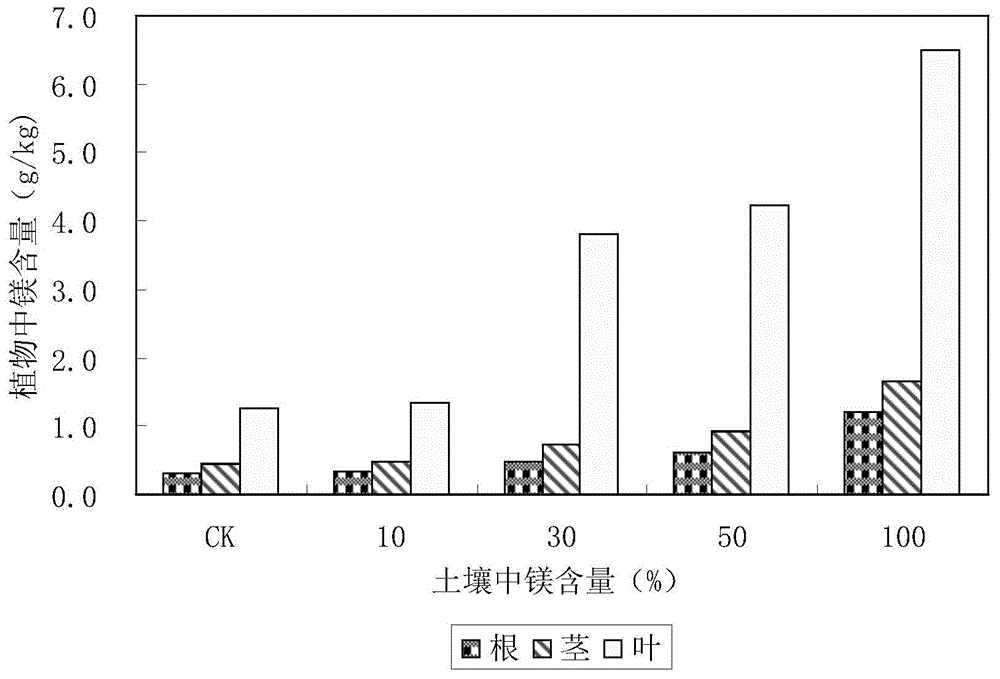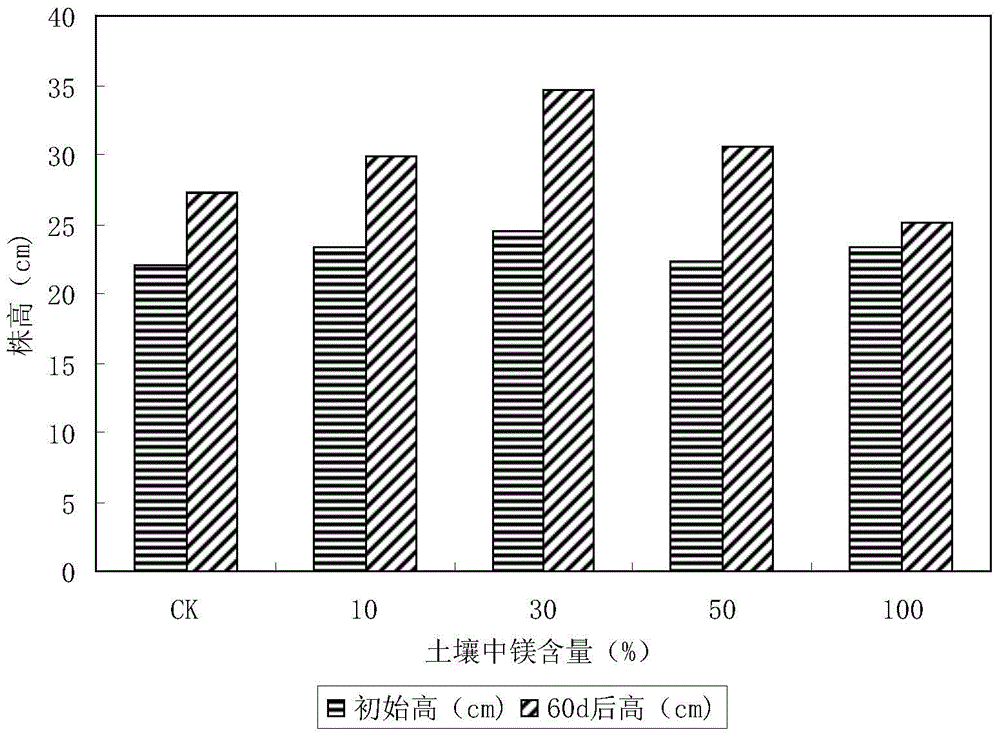Method for restoring magnesium polluted soil through paper mulberries
A technology of polluted soil and tree building, applied in the field of phytoremediation of contaminated soil, can solve the problems of few researches on the remediation of alkaline earth metal contaminated soil, and achieve the effects of rapid natural reproduction and growth, water and soil conservation, and strong germination
- Summary
- Abstract
- Description
- Claims
- Application Information
AI Technical Summary
Problems solved by technology
Method used
Image
Examples
Embodiment 1
[0023] The experiment site is located in the Shenyang Ecological Station of the Chinese Academy of Sciences, which is located in the center of the Lower Liaohe Plain, about 35km away from Shenyang City, and belongs to the warm temperate zone semi-humid continental climate. Potted plants were used to simulate magnesium-contaminated soil, and the soil was collected at this experimental station. The pH of the soil is 6.8, the organic matter is 2.64%, the total carbon content is 17.8g·kg-1, the total nitrogen content is 1.1g·kg-1, and the total phosphorus is 0.35g·kg-1.
[0024] The collected soil was air-dried indoors, and after a week, it was ground and mixed evenly. Weigh 3240g of uncontaminated soil in each pot, add 360g of magnesium ore dust (or ore, ore is collected from the magnesite mining area rock discharge field), and the magnesium ore dust (mineral powder is MgO, or ore) is mixed evenly and loaded Into the pot, make the magnesium content in the soil 10%. There is one...
Embodiment 2
[0026] The experimental site is the same as in Example 1.
[0027] The collected soil was air-dried indoors, and after a week, it was ground and mixed evenly. Every pot claims 2520g uncontaminated soil, adds 1080g magnesium ore dust (magnesium ore dust is the same as embodiment 1), it is mixed homogeneously, packs in the pot. There is one plant per pot of mulberry saplings, which are purchased from Dalian Zhongzhi Environmental Biotechnology Co., Ltd. First pass through the slow seedlings. The slow seedlings are first moved into uncontaminated soil and cultivated in a greenhouse at a temperature of 25-30°C. Watering 1-2 times a week according to the actual situation of soil moisture ensures that the soil moisture remains at About 60-80% of the field water holding capacity, grow for 30 days. Then transplant it into a pot and add 1000 g of water. Placed in a lighthouse for cultivation. The photoperiod is 16h / 8h, and the room temperature is 25°C. Regularly spray 400ml of wat...
Embodiment 3
[0029] The experimental site is the same as in Example 1.
[0030]The collected soil was air-dried indoors, and after a week, it was ground and mixed evenly. Every pot claims 1800g uncontaminated soil, adds 1800g magnesium ore dust (magnesium ore dust is the same as embodiment 1), it is mixed homogeneously, packs in the pot. There is one plant per pot of mulberry saplings, which are purchased from Dalian Zhongzhi Environmental Biotechnology Co., Ltd. First pass through the slow seedlings. The slow seedlings are first moved to the uncontaminated soil and cultivated in a greenhouse at a temperature of 25-30°C. Watering 1-2 times a week according to the actual situation of soil moisture to ensure soil moisture Keep at 80% of field water capacity and grow for 30 days. Then transplant it into a pot and add 1000 g of water. Placed in a lighthouse for cultivation. The photoperiod is 16h / 8h, and the room temperature is 25°C. Regularly spray 400ml of water every week. After cultu...
PUM
 Login to View More
Login to View More Abstract
Description
Claims
Application Information
 Login to View More
Login to View More - R&D
- Intellectual Property
- Life Sciences
- Materials
- Tech Scout
- Unparalleled Data Quality
- Higher Quality Content
- 60% Fewer Hallucinations
Browse by: Latest US Patents, China's latest patents, Technical Efficacy Thesaurus, Application Domain, Technology Topic, Popular Technical Reports.
© 2025 PatSnap. All rights reserved.Legal|Privacy policy|Modern Slavery Act Transparency Statement|Sitemap|About US| Contact US: help@patsnap.com


